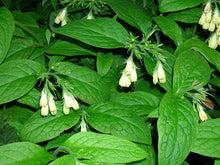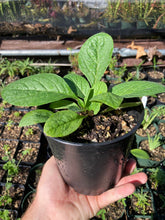Also known as “knitbone”, Comfrey was used as far back as the ancient Greeks as a poultice on small wounds and as a healing tea. More modern uses include roasting and grinding leaves to brew an herbal coffee alternative. Leaves are slightly toxic if eaten raw. Tuberous comfrey distinguishes itself from common comfrey in that it has smaller leaves and white flowers rather than purple/blue flowers. As its name indicates, the plant spreads through underground tubers or "rhizomes", making it much hardier and able to survive extremes of heat and cold.
Growth Form: herbaceous ground cover with small hanging white flowers, spreads easily
Light: Part Sun - Part Shade
Water: Generous water while establishing, can tolerate low water after established.
Soil: Rich loam, standard potting soil
Hardiness: USDA zones 4-8, extra water and protection from sun in zones 9&10
Type: Perennial




